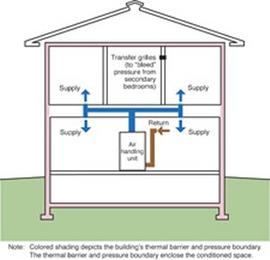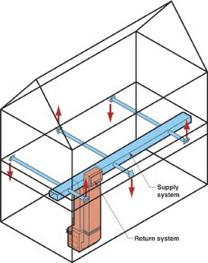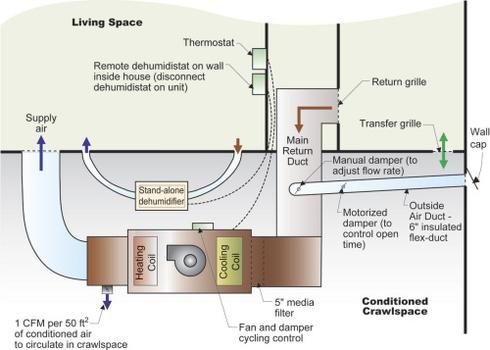This two-story enclosure with a crawlspace is designed for Charlotte, NC (Mixed-Humid Climate). It features a vented attic with a raised heel truss and cavity insulation at the attic floor, and asphalt shingles. The 2x6 advanced wood frame walls are insulated with cavity insulation and 1” XPS rigid insulation on the exterior, and feature a a brick veneer and wood cladding. The rim joist is insulated with an unfaced fiberglass batt or spray foam insulation on the interior. Rigid insulation with joints taped or sealed is installed on the interior of the crawlspace wall.
Enclosure Design
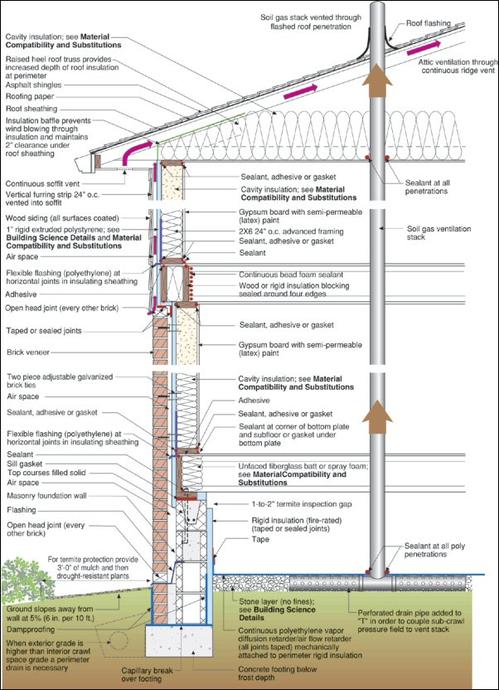
Construction Recommendations
- Foundation: Conditioned crawl space
- Above Grade Wall: Wood frame
- Cladding (1st floor): Brick veneer; (2nd floor): Wood siding
- Attic: Unconditioned
- Roof: Asphalt shingles
Building Science Notes
Ducts in conditioned space - This building profile is designed to accommodate HVAC equipment and ducts in either the living space or in the conditioned crawlspace. HVAC ducts should not be run in exterior walls.
Conditioned crawlspace – Conditioning of the crawlspace means that this space must be constructed much like a living space — it must be supplied by the HVAC system and have a transfer grille to return air back to the HVAC system located in the living space. The supply air should be directed horizontally across the crawlspace with good enough “throw” to provide some mixing, not directed down at the floor. Sizing of the supply air should be about 5% of the conditioned crawlspace floor area (For example: 0.05 cfm/ft2*1600ft2=80 cfm for a 1,600 ft2 conditioned crawlspace). A single 6-inch diameter supply duct typically suffices. Transfer air should go back to the central area of the living space above the crawlspace. Two grilles (10 inches by 4 inches) on opposite sides of the crawlspace will usually be sufficient. The transfer area should be calculated in the same manner as for closed bedrooms connecting to hallways, using the 3 Pa pressure difference limit. Some form of mechanical moisture control for the crawlspace is necessary. We recommend one of the following approaches:
A controlled ventilation strategy using the intermittent central fan-integrated supply — it provides both mixing and moisture removal for the crawlspace as well as the house.
A stand-alone dehumidifier installed in the crawlspace.
A continuously-operating crawlspace exhaust fan with make-up air extracted from the house.
In the assembly the rigid insulation is applied to the interior face of the exterior foundation walls. Moisture control is important to proper performance, in particular the vapor barrier ground cover on the floor of the crawlspace. The vapor barrier must be continuous and sealed to the perimeter wall and any supporting piers.
Air sealing details at transitions – Air sealing can be particularly difficult, but no less important, at assembly transitions such as band joists and between attached garages and living spaces. These are discussed below because they have proven to be a consistent challenge for builders.
- Band joists – Continuity of an exterior air barrier can be maintained at the band joist with sealed or taped housewrap or rigid foam insulation. Continuity of an interior air barrier can be maintained through a combination of cut foam blocks and sealant/caulk, rigid draftstopping material (wood blocking) and sealant/caulk, or spray foam. Note that neither cellulose nor fiberglass (batt or blown) can be used for the air barrier. The air barrier detail on second-story band joists is important because it is inaccessible (covered by structural/finish floor and ceiling finish) after construction. The air barrier/thermal barrier detail is important on ground floor band joists because of the thermal bridge that can occur at the top of basement and crawlspace foundation walls (as the result of the air barrier and thermal barrier moving from the outside to the inside of the building enclosure and termite inspection zones located at the top of basement and crawlspace foundation walls). Note that while fiberglass batts fulfill the requirement for protection from ignition in the open band joists, fiberglass batt material by itself cannot maintain the air barrier.
- Attached garages – The building enclosure surfaces shared between conditioned space and an unconditioned garage must have a continuous air barrier. See Figure 1 for details in terms of using sealants and rigid insulation to create a continuous air barrier between the attached garage and living space. For more details see Air Sealing / Air Drywall Approach Details.
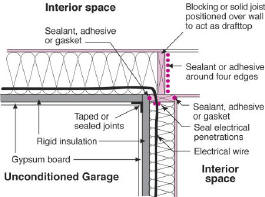
Figure 1
Drying mechanisms – In any climate, vapor control is based on the relationships among the following: the permeability of wall components, the type of cladding (reservoir or non-reservoir), the presence/lack/nature of an air space, and the magnitude/duration of the vapor drive (based on the relationship between the exterior and interior moisture content and temperature differences). This is not always possible when rigid exterior insulating sheathings (with low vapor permeability) are used; drying must take place primarily to the interior (the majority of drying occurring during the summer months).
In Mixed-Humid climates, roof and wall assemblies are best designed to dry to both the exterior and interior. This is not always possible when rigid exterior insulating sheathings are used due to their low vapor permeability. With insulating sheathings only inward drying is possible. Accordingly, the majority of drying occurs to the interior during the summer months. Therefore, interior vapor barriers should not be installed. Note that there is a difference between an interior vapor barrier and an interior vapor retarder (see “Insulations, Sheathings, and Vapor Diffusion Retarders." Particular care must be taken to prevent the entry of bulk water (i.e. leaks) and to control interior relative humidity in the coldest months. See Material Compatibility and Substitutions. The moisture potential represented by the reservoir wall claddings is controlled by a fully vented air space. The conditioned crawlspace will dry primarily to the exterior, given the vapor permeability of the concrete block and brick veneer.Drainage plane, air barrier, vapor control – The drainage plane runs along the exterior surface of the foam sheathing. All vertical joints must be shiplapped, flashed, or sealed; all horizontal joints must be sealed or taped.
This building profile has a continuous air barrier on the interior (Airtight Drywall Approach on ceiling and walls. See Air Sealing / Air Drywall Approach Details and on the exterior walls (the sealed rigid insulation).
In Mixed climates, wall and roof assemblies can be designed to dry primarily to the exterior (during the heating season), to the interior (during the cooling season), or in both directions. This last, the bi-directional drying potential, is generally the preferred approach. For more detailed discussion of the three approaches, see the discussion of wall and roof design in the Builder’s Guides. Since the permeability of the latex-painted gypsum board is greater than that of the XPS rigid insulation, this wall assembly will generally dry to the interior.Rough opening flashing – Flashing must be installed at the plane of the XPS rigid insulation for drainage plane continuity. See Figure 2 and theWater Management Guide for sequential flashing details.
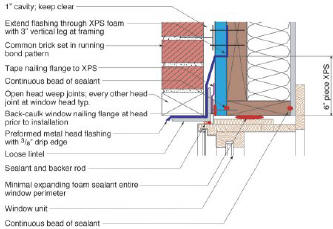
Figure 2
Advanced framing – This wall assembly replaces structural sheathing with cross bracing or some alternative for shear resistance. Thermal performance and reduced drywall cracking are additional benefits of a comprehensive approach to advanced framing. See Advanced Framing Details for details.
Soil gas ventilation – The sub-crawl ground cover to roof vent system handles conditions that are difficult if not impossible to assess prior to completion of the structure—resultant confined concentrations of air-borne radon, soil treatments (termiticides, pesticides) methane, etc. The cost of this “ounce” of prevention is well balanced against the cost of the “pound” of cure.
Sub-crawl ground cover stone bed - The four-inch deep, 3/4-inch stone bed functions as a granular capillary break, a drainage pad, and an air pressure field extender for the soil gas ventilation system. Without it, a soil gas ventilation system is not practically possible.
Thermal barrier – Cavity-warming exterior rigid insulation is important in this climate where the average monthly temperature for the coldest month of the year goes below 45°F (see Unvented Roofs for more information). The rule of thumb that BSC uses is 1/4-inch of rigid insulation per 1,000 heating degree days (HDD); one inch of rigid insulation works well for this climate. The heat loss through the crawlspace walls is significant enough to warrant insulation. Note that the insulation must comply with local codes for protection against ignition.
Crawlspace access – The preferred location for crawlspace access is through the subfloor; any access through the perimeter wall must be airsealed and insulated.
Climate Specific Details
Vented attic – Soffit and ridge vents provide more effective attic ventilation than gable-end vents. Gable exhaust fans do not provide effective attic ventilation. They are generally temperature-controlled, when relative humidity is often the condition that requires higher ventilation rates. They can also depressurized the house causing loss of conditioned air. Generally, the area of the gable and soffit vents, combined with the leakage of the attic ceiling, is such that the fan pulls air not just from the exterior vent but from the conditioned space below.
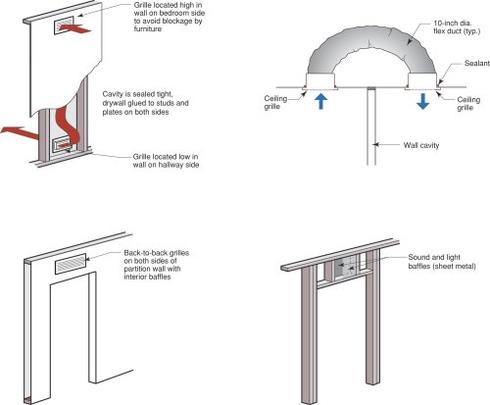
Figure 3a-d
- Mechanical systems
- Heating and Cooling – Recommend sealed combustion 90+ condensing gas furnace or air-source heat pump, Energy Star-rated or better (HSPF ≥ 8.0). See Energy Star Air-Source Heat Pumps. Follow appropriate sizing procedures. See the Cooling System Sizing Procedures for more detailed information.
- Ducting - Single return requires transfer grilles to provide path and avoid pressurizing bedrooms as shown in Figures 3a-d.
- Mechanical ventilation
- Intermittent central-fan-integrated supply, designed to ASHRAE 62.2 rate, with fan cycling control set to operate the central air handler as much as 33% of the time, but not less than 25% of the time, occurring within at least every three hours to provide ventilation air distribution and whole-house averaging of air quality and comfort conditions ($125 to $150). Optionally include a normally closed motorized damper in the outside air duct with the AirCycler® FRV control (+$50 to $60). Optional dehumidification separate from cooling (+$300 to $350). See Figures 4, 5 and 6.
Supplemental dehumidification - Although high performance homes in this climate rarely require supplemental dehumidification, it is:
… one of three strategies appropriate for conditioned crawlspaces (see Building Science Notes),
… may be desired in homes with full basement foundations, and,
… is strongly recommended when occupants require humidity control (and high-efficiency air filtration) for asthma trigger control.
There are a number of different ways to accomplish supplemental dehumidification with varying costs and performance advantages (for a detailed discussion of supplemental dehumidification see Conditioning Air). Described below is one low-cost yet effective approach and one more costly but higher performance/systems-engineered approach:
1. Ducted stand-alone dehumidifier: This system is a "site-constructed" one consisting of an off-the-shelf standard dehumidifier ducted in the attic and controlled by a dehumidistat located in the living space. This arrangement of individual components has proven to be an effective and economical system for the production home building setting. The installed cost ranges from approximately $350 to $550. The system is comprised of a GE dehumidifier model AHG40FCG1 (dehumidifier located in attic in an insulated enclosure and ducted to living space), Honeywell dehumidistat model H8808C located in living space, and Honeywell switching relay (with transformer) model RA89A 1074. See Figure 6. The selection of the dehumidifier is based largely on the fact that it has a blower wheel rather than paddle fan that moves air more efficiently in its ducted box configuration.
Note: The following manufacturers make Energy Star-qualified blower wheel stand-alone dehumidifiers:- LG Electronics (all models):
- Haier America (all models):
- Heat Controller (all BHD models use a turbo-impeller with turned blades):
- Or you can check the EPA Energy Star website for dehumidifiers from these manufacturers
2. Aprilaire 1700: This is a truly engineered, coherently manufactured, supplemental dehumidification system with built-in air filtration, ducted design, and a controls package that integrates central blower cycling for distribution, dehumidification and intermittent introduction of outside air ventilation. The system is also designed for flexibility-it can be connected to the conditioned space directly or to the central air distribution system in a number of configurations. It's also compact and lightweight enough to be set on or hung from most framing. The product cost for this system is currently about $1,100. For more information, see: http://aprilaire.com
For more information on other high performance supplemental dehumidification systems, see: http://www.thermastor.com.Termite management – Termites are best managed with a three-pronged approach that deals with the three things termites need—cover from sunlight, moisture, and food (wood or paper):
Reduced cover – Keep plantings 3 feet away from the building perimeter, thin the ground cover (wood mulch or pea stone) to no more than two inches depth for the first 18 inches around the building, and maintain any termite inspection zone on the foundation.
Control moisture – Maintain slope away from building as shown, carry roof load of water at least three feet away from building, and make sure that irrigation is directed away from the building.
Chemical treatment – Use an environmentally-appropriate soil treatment (such as Termidor®) and a building materials treatment (such as Bora-Care®) for termite-prone near-grade wood materials.
Inter-relationship of first three points – Since a builder and a homeowner’s ability to employ or stick to each of the three strategies above will vary, make sure that an inability to fully employ one strategy is compensated for by complete rigor with the others. For example, if for some reason, chemical treatment of soil or building materials is not an option, then complete rigor in moisture control and ground cover is required.
Field Experience Notes
Termite control – Local codes and interpretations by building inspectors can make details involving rigid insulation difficult. We have found that the top-of-foundation wall inspection zone shown in this building profile meets with building official acceptance and results in a limited break in the thermal barrier.
Air sealing – Most codes can be interpreted to require only protection of foam from “ignition” in crawlspaces (“where entry is made only for service of utilities”). The same applies to foam at the rim joist (this is an interstitial space protected from ignition by gypsum wall board on one side and floor sheathing on the other). Protection from ignition can be accomplished with 11/2-inch-thick (38 mm) mineral fiber insulation, 1/4-inch-thick (6.4 mm) wood structural panels, 3/8-inch (9.5 mm) particleboard, 1/4-inch (6.4 mm) hardboard, 3/8-inch (9.5 mm) gypsum board, or corrosion-resistant steel having a base metal thickness of 0.016 inch (0.406 mm)
Brick veneer and the air space – Harking back to “old-timer” practices, place sand at the bottom of the 1-inch air space to acting as a bond break for mortar droppings and leave bricks out intermittently in the first course. After the veneer is completed, the sand and mortar droppings can be easily removed and the missing course brick mortared in. Head joints in the top and bottom course must be left clear for top and bottom venting of this space. Masons must also be aware of protecting the integrity of the XPS foam sheathing as they work, given its function as the wall’s drainage plane. Educate this trade with some building science basics about the impact of their work on building enclosure performance.
Brick ties – The two-piece adjustable ties are strongly recommended, given the 1-inch air space and foam insulation.
HVAC commissioning – The most efficient equipment means little if the system is not set up and started up properly. Follow high performance start-up procedures (although this resource is primarily for refrigerant cooling systems, most of it applies to heat pumps).
Conditioned crawlspaces– This assembly may require some local building code official "building science persuasion." See the Building Safety Journal article written by Peter Yost of BSC.
Energy trusses – There are a number of different truss configurations that yield greater depth at the heel, but they vary quite a bit in cost. The truss shown above right (sometimes called a “slider” truss – see Figure 7) has proven to be among the most cost-competitive. And of course, the pitch of the roof affects just how much insulation you can get at this location, regardless of the type of truss.
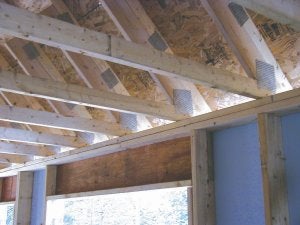
Figure 7
Advanced framing – For a technical resource that may help with resistance to advanced framing methods from local code officials, see the Building Safety Journal article written by Peter Yost of BSC.
Material Compatibility and Substitutions
Exterior sheathing – The use of other common exterior sheathing materials—OSB, plywood or thin-profile structural sheathing (e.g. Thermo-ply®)—in this assembly must be done with recognition of the impact on heat and moisture transfer.
Both OSB and plywood are more vapor permeable than rigid foam insulation, a good thing when the cavity-warming ability of the rigid insulation is lost. But keep in mind that behind the brick veneer (a reservoir cladding), the greater vapor permeability of the OSB or plywood heightens the importance of the continuous 1-inch air space.
On the other hand, Thermo-ply® is less vapor permeable than rigid foam insulation and will pretty much eliminate drying potential to the exterior, a potential problem during the heating season, particularly the further north you build in this Mixed climate. Builders in the northern half of this climate region who use Thermo-ply® as an exterior sheathing should ensure that controlled ventilation and occupant use of point exhaust fans keep the interior relative humidity below 30% during the peak of their heating season.
Drainage plane on rigid insulation – An alternative to flashing, shiplapping or sealing the XPS insulation for continuity of the drainage plane is to apply a housewrap to the outside of the insulation. The housewrap then becomes the continuous drainage plane.
Interior latex paint - The substitution of low permeability interior finishes (vinyl wall paper, oil-based paints) for latex paint is strongly discouraged as drying to the interior is important in mixed-humid climates.
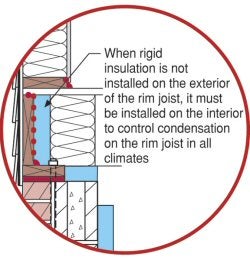
Figure 7a
Rim joist insulation - Fiberglass cavity insulation at the rim joist is only acceptable if the exterior sheathing is cavity-warming rigid foam insulation that extends down over the entire rim joist. If non-insulating exterior sheathing is used at the rim joist then one of the following insulation details must be used at the rim joist (see Figure 7a) to manage condensation potential:
- Spray foam insulation in the rim joist cavity
- Fully air-sealed rigid insulation
- Inset rim joist with rigid insulation between the exterior sheathing and the rim joist
Cavity insulation materials – Acceptable cavity insulation includes any that have a relatively high vapor permeability—cellulose, fiberglass, foam (as long as air sealing is accomplished by a separate component or system when cellulose or fiberglass is used). User discretion can be based on properties other than building science.
Crawlspace floor – Ideally, the crawlspace floor would be a four-inch gravel (free-draining, no fines) bed, polyethylene layer and "rat" (2-inch low strength cast concrete) slab, making this space more amenable to light storage and housing of HVAC equipment. The cost of this approach may outweigh the benefits for builders and buyers. If a concrete slab is cast, it should be placed directly on top of the vapor barrier.
Gypsum wallboard – Areas of potentially high moisture, such as bathrooms, basements, and kitchens, are excellent candidates for non-paper faced wallboard systems (e.g. James Hardie’s Hardibacker®, GP’s DensArmor®, USG’s Fiberock®). In addition, paper-faced gypsum board should never be used as interior sheathing or backer for tub or shower surrounds where ceramic tile or marble (any material with joints or grout lines) is used as the finish.

